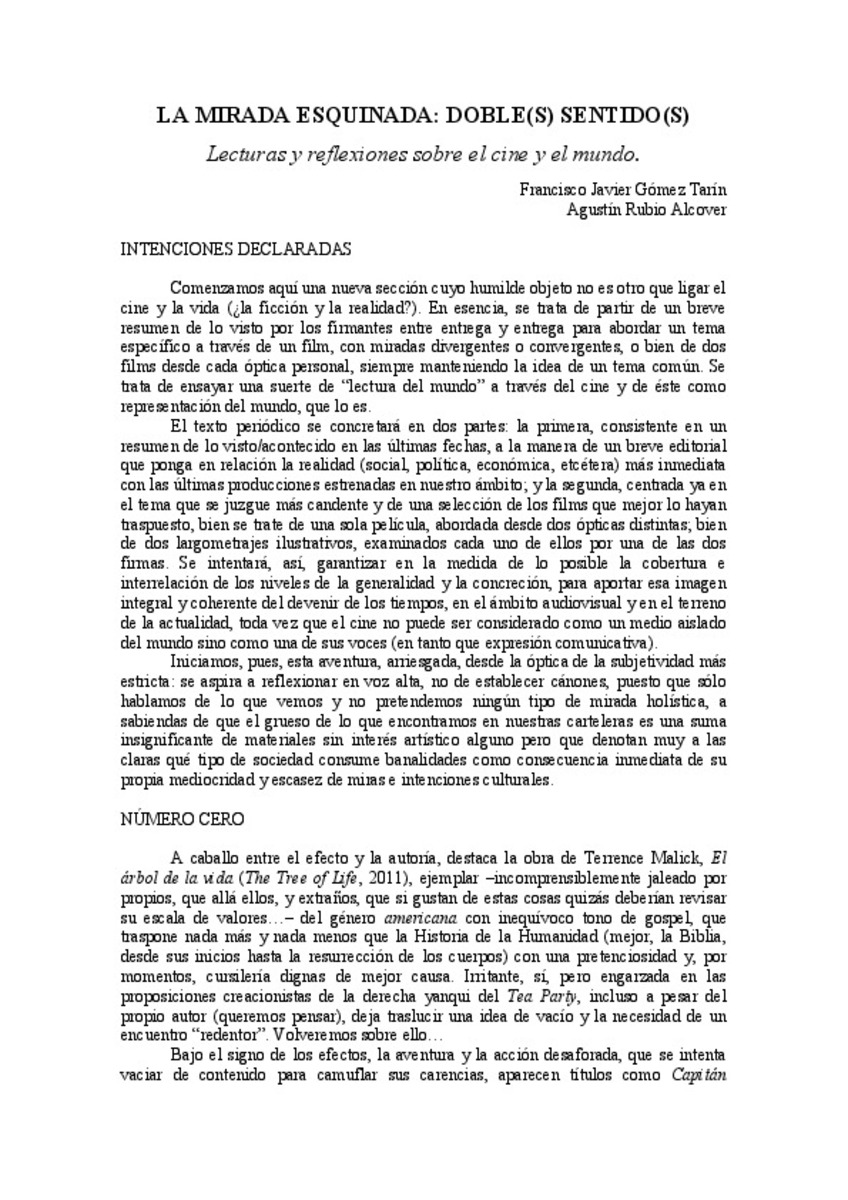| dc.contributor.author | Rubio Alcover, Agustín | |
| dc.contributor.author | Gómez-Tarín, Francisco Javier | |
| dc.date.accessioned | 2013-05-10T09:16:48Z | |
| dc.date.available | 2013-05-10T09:16:48Z | |
| dc.date.issued | 2012-01 | |
| dc.identifier.issn | 0210-2706 | |
| dc.identifier.uri | http://hdl.handle.net/10234/63091 | |
| dc.description.abstract | Here we begin another section whose humble goal is none other than to connect cinema with life (fiction and reality?). Essentially, the idea is to set out from a short summary of what the authors have seen between one instalment and the next in order to address a specific subject either using diverging or converging views of a film or using two films seen from two personal perspectives. The idea of a common topic is, however, always maintained. The intention then is to produce a kind of “interpretation of the world" through cinema and of this as a means of representing the world, which it is. The text will consist of two parts: the first will be a summary of what has been seen/has taken place recently, in the form of a sort of short editorial that highlights the relation between the most immediate (social, political, economic, etc.) reality and the latest productions released in our area. The second will focus on what is seen as the hottest topic and a selection of films that have best portrayed it, either as one film that has addressed it from two different angles or two illustrative films, each of which is examined by one of the authors. By so doing, we will attempt to ensure as far as possible that the levels of generality and concretion are covered and interrelated, so as to provide that integrated, coherent image of the passing of time, both in the audiovisual sphere and in the domain of current affairs. At the same time it must be borne in mind that cinema cannot be considered a medium that is isolated from the world but rather as one of its voices (given its nature as a means of communicative expression). Thus, we start out on this risky adventure from the strictest subjective perspective: the aim is to think out loud, not to establish canons, since we only speak of what we see and we have no intention of reaching any sort of holistic view, as we know that most of what is shown in our cinemas is an insignificant sum of materials of no artistic interest whatsoever. Nevertheless, they do clearly show what kind of society consumes banalities as a consequence of its own mediocrity and its cultural short-sightedness and narrow intentions | |
| dc.description.abstract | Comenzamos aquí una nueva sección cuyo humilde objeto no es otro que ligar el
cine y la vida (¿la ficción y la realidad?). En esencia, se trata de partir de un breve
resumen de lo visto por los firmantes entre entrega y entrega para abordar un tema
específico a través de un film, con miradas divergentes o convergentes, o bien de dos
films desde cada óptica personal, siempre manteniendo la idea de un tema común. Se
trata de ensayar una suerte de “lectura del mundo” a través del cine y de éste como
representación del mundo, que lo es.
El texto periódico se concretará en dos partes: la primera, consistente en un
resumen de lo visto/acontecido en las últimas fechas, a la manera de un breve editorial
que ponga en relación la realidad (social, política, económica, etcétera) más inmediata
con las últimas producciones estrenadas en nuestro ámbito; y la segunda, centrada ya en
el tema que se juzgue más candente y de una selección de los films que mejor lo hayan
traspuesto, bien se trate de una sola película, abordada desde dos ópticas distintas; bien
de dos largometrajes ilustrativos, examinados cada uno de ellos por una de las dos
firmas. Se intentará, así, garantizar en la medida de lo posible la cobertura e
interrelación de los niveles de la generalidad y la concreción, para aportar esa imagen
integral y coherente del devenir de los tiempos, en el ámbito audiovisual y en el terreno
de la actualidad, toda vez que el cine no puede ser considerado como un medio aislado
del mundo sino como una de sus voces (en tanto que expresión comunicativa).
Iniciamos, pues, esta aventura, arriesgada, desde la óptica de la subjetividad más
estricta: se aspira a reflexionar en voz alta, no de establecer cánones, puesto que sólo
hablamos de lo que vemos y no pretendemos ningún tipo de mirada holística, a
sabiendas de que el grueso de lo que encontramos en nuestras carteleras es una suma
insignificante de materiales sin interés artístico alguno pero que denotan muy a las
claras qué tipo de sociedad consume banalidades como consecuencia inmediata de su
propia mediocridad y escasez de miras e intenciones culturales. | |
| dc.format.extent | 10 p. | ca_CA |
| dc.format.mimetype | application/pdf | ca_CA |
| dc.language.iso | spa | ca_CA |
| dc.publisher | Ediciones de Intervención Cultural | ca_CA |
| dc.relation.isPartOf | El Viejo Topo. 2012, 288 | ca_CA |
| dc.rights.uri | http://rightsstatements.org/vocab/CNE/1.0/ | * |
| dc.subject | No habrá paz para los malvados | ca_CA |
| dc.subject | Enrique Urbizu | ca_CA |
| dc.subject | Capitán Trueno y el Santo Grial | ca_CA |
| dc.subject | Antonio Hernández | ca_CA |
| dc.subject.other | No habrá paz para los malvados (Pel·lícula cinematogràfica) | ca_CA |
| dc.subject.other | Urbizu, Enrique -- Crítica i interpretació | ca_CA |
| dc.subject.other | Capitán Trueno y el Santo Grial (Pel·lícula cinematogràfica) | ca_CA |
| dc.subject.other | Hernández, Antonio, 1953- -- Crítica i interpretació | ca_CA |
| dc.title | La mirada esquinada: doble(s) sentido(s). Lecturas y reflexiones sobre el cine y el mundo. Intenciones declaradas | ca_CA |
| dc.type | info:eu-repo/semantics/article | ca_CA |
| dc.rights.accessRights | info:eu-repo/semantics/openAccess | ca_CA |
| dc.relation.publisherVersion | http://www.elviejotopo.com/web/revistas.php?numRevista=288 | |







